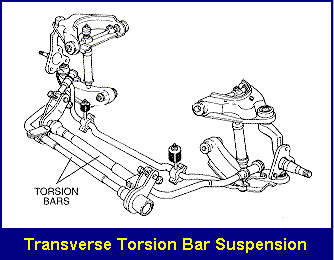SPRING DESIGN
Before discussing spring design, it is important to understand sprung and unsprung weight. Sprung weight is the weight supported by the springs. For example, the vehicle’s body, frame, motor, and transmission would be sprung weight. Unsprung weight is the weight that is not carried by the springs, such as the tyres, wheels and brake assemblies.
The springs allow the frame and vehicle to ride undisturbed and the suspension and tyres to follow the road surface. Reduced unsprung weight will provide less road shock. A high sprung weight along with a low unsprung weight provides improved ride and also improved tyre traction.
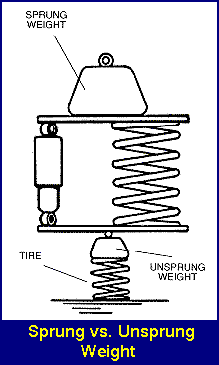
There are four major spring designs in use today: coil, leaf, torsion bar, and air.
The most commonly used spring is the coil spring. The coil spring is a length of round spring steel rod that is wound into a coil. Unlike leaf springs, conventional coil springs do not develop inter-leaf friction. Therefore, they provide a smoother ride.
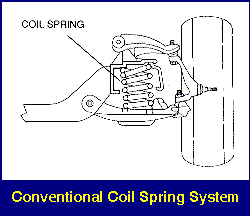
Coil spring strength, or rate, is determined by the length and diameter of the rod. Decreasing the diameter of the rod, the number of turns, and the tightness of the turns increases the strength of the spring. Increasing the rod diameter or the number of turns, or increasing the space between turns reduces spring strength.
Spring rate, sometimes referred to as deflection rate, is used to measure spring strength. It is the amount of weight that is required to compress the spring one inch. For example: if it takes 100 pounds to compress a spring one inch, it would take 200 pounds to compress the spring two inches.

Some coil springs are made with a variable rate. This variable rate is accomplished by either constructing the spring from material having different thicknesses, or by winding the spring so the coils will progressively bottom out. Variable rate springs provide a lower spring rate under unloaded conditions offering a smoother ride, and a higher spring rate under loaded conditions, resulting in more support and control.
Coil springs require no adjustment and for the most part are trouble-free. The most common failure is spring sag. Springs that have sagged below vehicle design height will change the alignment geometry. This can create tyre wear, handling problems, and wear on other suspension components.
During suspension service it is very important that vehicle ride height be measured. Ride height measurements not meeting manufacturer’s specifications require replacement of the springs.
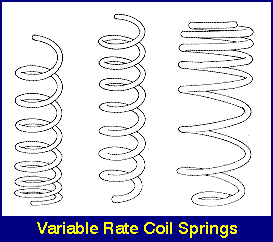
Leaf springs are designed two ways: multileaf and mono leaf. The multileaf spring is made of several steel plates of different lengths stacked together and held by clips. During operation, the spring compresses to absorb road shock. The spring plates bend and slide on each other allowing movement.
The mono leaf spring is an example of a tapered leaf spring. The leaf is thick in the middle and tapers outward to the two ends.
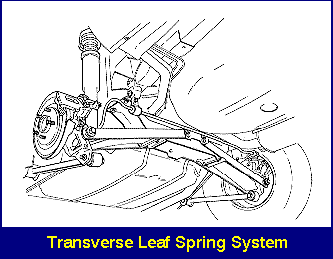
Some vehicle manufacturers will use a transverse, or side-to-side, leaf spring. Normally, a transverse spring can be a steel multileaf or a composite mono-leaf. Composite springs are also used in longitudinal, or front-to-back, leaf spring applications.
Another type of spring is the torsion bar. The torsion bar is a straight or L-shaped bar of spring steel. Most torsion bars are mounted solidly to the frame, with the other end connected to the suspension. During suspension movement, the torsion bar will twist providing spring action.
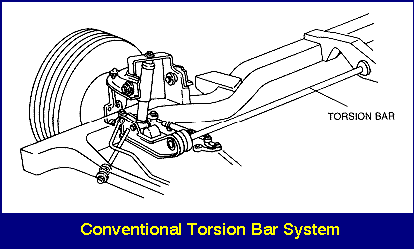
The air spring is another type of spring that is becoming more popular on passenger cars, light trucks, and heavy trucks. The air spring is a rubber cylinder filled with compressed air. A piston attached to the lower control arm moves up and down with the lower control arm.
This causes the compressed air to provide spring action. If the vehicle load changes, a valve at the top of the air bag opens to add or release air from the air spring. An on-board air compressor supplies air.
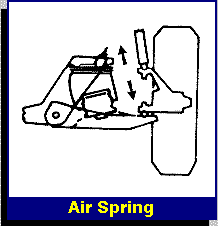
An often overlooked spring is the tyre. Tyres are air springs that support the total weight of the vehicle. The spring action of the tyre is very important to the ride quality and safe handling of the vehicle. As a matter of fact, tyres may be viewed as the number one ride control component. Tyre size, construction, compound and inflation are very important to the ride quality of the vehicle. The spring rate of a tyre is determined by the air pressure. An over-inflated tyre will have a higher spring rate and will produce excessive road shock.
Over-inflated tyres will transmit road shock rather than reduce it. Over- or under-inflation also affects handling and tyre wear.
When adjusting tyre pressure always refer to the vehicle manufacturer’s specifications, not the specifications on the side of the tyre. The air pressure specified by the vehicle manufacturer will provide safe operation and ride quality of the vehicle. The tyre pressure stamped on the side is the maximum pressure that the tyre is designed to hold at a specific load and speed.
